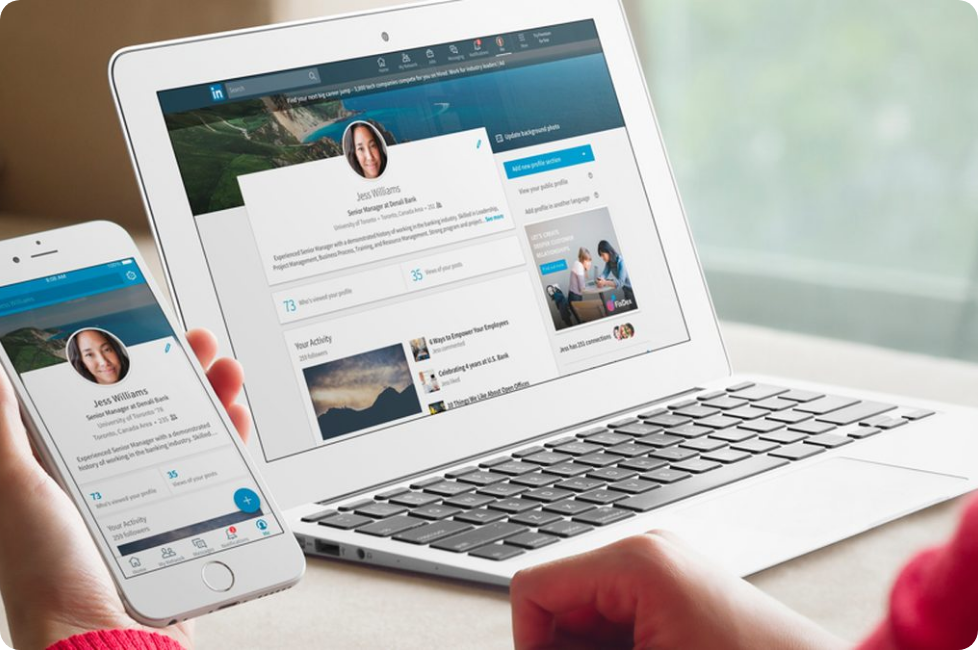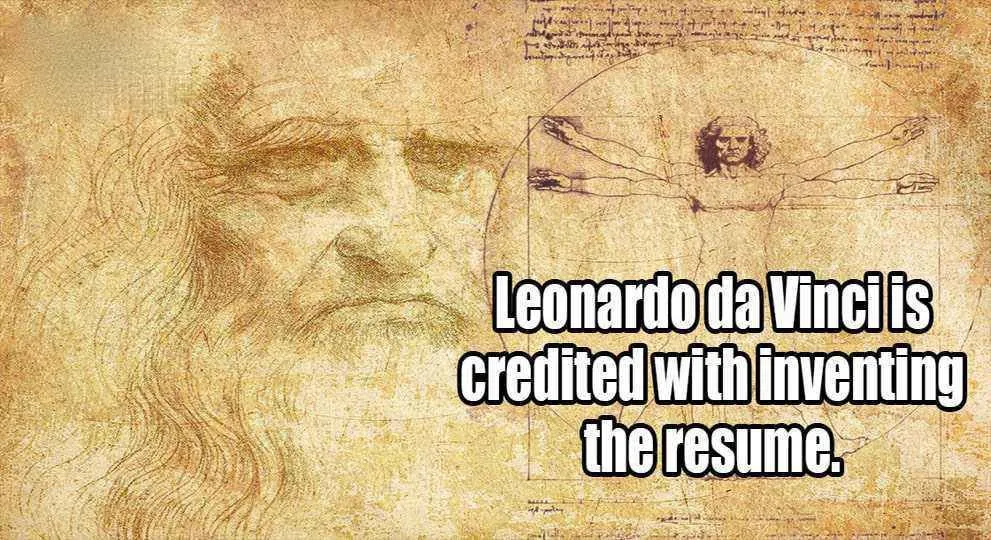Why You Need A
Linkedin Profile:
Fact: 94% Of Recruiters Use
Linkedin While Only 36% Of
Job Seekers Do!

Fact: 94% Of Recruiters Use
Linkedin While Only 36% Of
Job Seekers Do!
Your LinkedIn profile is key to your professional branding strategy. However, it doesn’t matter who you are or what you do; it’s not easy to write about yourself.
Besides, who can find the time (or inclination) to complete their LinkedIn profile on their own?
You are missing opportunities and networking potential each and every day that your LinkedIn profile remains a skeleton of what you offer.
It’s time to transform your underperforming LinkedIn profile into a POWERFUL career tool that spotlights your skills, experiences AND impresses your network of connections.
The good news is you don’t have to go it alone. My team of Professional Branding Specialists will work directly with you to create a unique professional profile that impresses your network, builds your brand, and helps you achieve your goals. We take the time to learn about you and your goals to create a strategic profile that performs effectively.
My team will work closely with you to create a high-level, goal-oriented LinkedIn profile that brands you effectively. The best news of all? My team does all the work. We write the profile and we even upload it for you. We pride ourselves in providing you with a LinkedIn profile that you are proud to have represent you online. We know how to brand you as an expert and help you connect with your target audience.
Social media has become a global hiring tool with 98% of Recruiters and 85% of Hiring Managers currently use LinkedIn to find candidates, according to von Rosen. Over 90% of employers are looking at LinkedIn profiles at some point during the hiring process. (Jobvite 2017)

LinkedIn is one of the best tools to find a job right
now. 10 steps for how to use LinkedIn effectively to
get more interviews and job offers.
We need to do three things if you want to find a
job on LinkedIn… 1. Set up a great LinkedIn profile
2. Use LinkedIn as a networking tool to get
interviews and make connections 3. Use LinkedIn
to apply directly to employers
Your headshot is one of the first things people see, so if you want to use LinkedIn to land a job, make sure your profile photo is giving off the right impression. Choose a photo that’s clear, professional, and friendly-looking. It doesn’t need to be stiff-looking (suit and tie), but you probably shouldn’t choose a photo where you’re drinking from a keg, either. You can also upload a background image to make your profile stand out further. However, your headshot is more important because that’s one of the things employers see BEFORE they even click your profile.
Next up, you’ll need a great LinkedIn headline. This is essential for using LinkedIn to get a job because everyone sees your headline – when you apply for a job, when they see you in search results, etc. Don’t put “actively seeking positions” – that tells employers nothing about what you do or why they should care. Make your headline about your skills and how you can help them. For example, you could say, “Experienced B2B sales professional responsible for $25MM in sales from 2017-Present” Or you could say, “Recent Biology graduate passionate about cancer research; winner of ___ award” You can see 10 full LinkedIn headline examples, and a detailed explanation of why NOT to say, “actively seeking opportunities” here. Like your headshot, your headline on LinkedIn is one of the few things people see BEFORE even clicking on you… for example, when you comment on an article or a friend’s post, share a post yourself, etc. So it’s very important if you want to stand out, make a good impression, and land jobs on LinkedIn.
Make sure you’re using all 50 skill slots that LinkedIn allows. This is a big part of how to use LinkedIn to find a job, because it will help you get spotted more. Recruiters are constantly searching LinkedIn, and skills count as keywords in your profile, which means they help you appear in more searches! For example, if a recruiter searches for “Phone Sales” and you’ve listed “Phone Sales” as a skill, it’ll make your profile show in their results. If you need ideas of what skills to put, glance at your own resume, and look at colleagues/peers in your industry on LinkedIn. What skills are your coworkers and LinkedIn connections listing? Use that as inspiration for your own profile.
Next, make sure your previous work is in bullet format and easy to read. You can put a one- or two-sentence description of each role before diving into bullet points, but avoid big blocks of text and long paragraphs. These tend to get skimmed over, and you want your LinkedIn to get READ. So this is important. Then, in your bullets, make sure you’re focused on detailed results and accomplishments. Put metrics, data, and numbers whenever possible. For example, don’t just say, “responsible for managing customer questions and requests”. Say, “successfully handled 100+ customer requests per week with a 99% customer satisfaction rating” That’s going to make your bullets stand out a LOT more and make employers want to interview you more, because you’re showing the exact type of results you’ll be able to get them.
You should be doing this with your resume bullet points, too.
We’re almost done setting up your LinkedIn profile to job search effectively. The next step is to ask one or two colleagues to write an endorsement for you. You can learn more about how to do this (including examples of good LinkedIn recommendations) here. Even one or two recommendations will help your profile stand out from all the competition when you’re trying to use LinkedIn to land a job.
Not every employer is going to care about volunteer work and community involvement, but some do! So if you’ve done anything, put it on your LinkedIn. LinkedIn has a profile section dedicated to this called “Volunteer Experience”.
Networking is by far the fastest way to find a job if done right. This article explains why (and how to get started). First, reconnect with past colleagues and tell them you’re job searching. Don’t ask for a big favor (like an introduction to a hiring manager) right away, especially if you haven’t spoken in a while. But do tell them you’re searching; nobody can help you if they don’t know! So, you might start by saying, “Hi Bill. How have things been going for you at Microsoft? I hope you’re well! I wanted to let you know that I’ve started looking for a new position – hopefully a Senior Supervisor or Manager position in Software QA. Do you know of any interesting companies that are hiring?” Next, start to build new connections. You could ask your existing contacts if there’s anyone in their next that they think you should speak with. And you can reach out to new people at companies you want to work for. Ask for something very small to begin, like: “I see you climbed the ranks very quickly to VP of Marketing. Do you have any advice for a newer marketer who hopes to accomplish the same?” Complimenting someone on their career and asking one single question is a good way to open the door to a conversation. After a few messages, you could then ask if their group is hiring. But don’t do it right away. And don’t attach a resume or cover letter in a first message to someone. This is NOT going to work. I get this all the time and it’s a big turn-off. It’s pushy and assumptive. Just start a regular conversation and you’ll be much better off.
You can also apply directly for jobs on LinkedIn via their Easy Apply feature. Search for job titles or keywords, narrow down by location and other search filters (LinkedIn has awesome filters), and then start applying. If a job offers “Easy Apply”, you can submit your details and attach a resume in just a few clicks without ever leaving LinkedIn. This is ideal because it saves you a ton of time. And if a job doesn’t offer “Easy Apply”, you can click through the company website and apply that way.
The more active you are, the more you’ll get seen by recruiters, potential new colleagues who can refer you to their company for a job, etc. One good way to get seen is following a few big influencers (like Bill Gates or Gary Vee) and commenting on their posts. When I comment on a “big” influencer’s post, my comment usually gets 10 likes. Whereas a regular comment of mine might get 0-2 likes. Then you can go connect with those people who liked your comment. You’ll build more and more connections by doing this. You never know when one connection will be able to introduce you to a hiring manager or get you an interview. So you need to just keep engaging and building your network if you want to use LinkedIn to find a job. You can also post content yourself – just keep it positive and professional. You can post examples of past work, case studies, interesting articles you find, questions, and more. The more active you are, the more you’ll get seen and potentially receive invitations to interview
Finally, put a link to your LinkedIn profile in the header of your resume (right after your phone number and email address). This will show employers you’re modern and up-to-date and will get them to click over to your LinkedIn and see all the great content you’ve added. This boosts your chances of getting invited to interview and lowers the risk that they’ll glance quickly at your resume and move on. Employers only spend 8-10 seconds reviewing your resume at first. Then, they decide if they want to read more or not. So a link up top can help you stand out and keep them reading for longer. Create a custom LinkedIn profile URL too, so your link is short and professional-looking. If you follow the steps above, you’ll be well on your way to using LinkedIn to get a great job. You’ll have an effective profile that impresses employers and gets you more interviews, and you’ll drive more people to view your LinkedIn profile, too.
As someone who has requested a resume to be written on his behalf from several consulting services over the years, I can say with absolute certainty that Mistry Resume is the best! Satish is kind, courteous, and delivers excellent customer service. Not only will he work with you to create a top notch resume, he provides invaluable guidance and tips for preparing job applications. Because of Satish, my resume is something I never thought it could be, while remaining 100% factual. I now have an even greater confidence when applying to job postings thanks to him!
As someone who has requested a resume to be written on his behalf from several consulting services over the years, I can say with absolute certainty that Mistry Resume is the best! Satish is kind, courteous, and delivers excellent customer service. Not only will he work with you to create a top notch resume, he provides invaluable guidance and tips for preparing job applications. Because of Satish, my resume is something I never thought it could be, while remaining 100% factual. I now have an even greater confidence when applying to job postings thanks to him!
I approached Mistry Résumé (Mistry Consulting Services Inc.) because I needed help in creating a professional resume that would become my key tool in applying for numerous jobs. I approached Satish Mistry because I was told from my girlfriend that he has years of experience and would be exactly the right person I needed in helping me create the perfect resume. He was exactly the right person I was looking for and was amazed with the abundance of knowledge Satish has in this field of work. The results were perfect and I could not thank him enough for his hard work and commitment in helping me. One thing I liked was the visual presentation of the resume which blew me away because of how clear and eye catching it was to look at! I found the experience very helpful and very useful. I could tell Satish has a lot of experience and a good understanding of what is needed to have a true professional resume. I would recommend Mistry Résumé (Mistry Consulting Services Inc.) to anybody and everybody because the value you get from them speaks for itself!
Mistry Résumé (Mistry Consulting Services Inc.) was everything I was looking for and more. Satish went above and beyond. He listened to exactly what I was needing, took the time to learn about the field I was applying for, and made a cover letter and resume which was world class! He was very prompt in answering questions, and providing feedback. Satish even made a list of interview tips etc to help in my interview process. I definitely recommend Satish and I look forward to working with him in the future!
Let me say that probably the best services I have got in Canada since I moved here more then 5 years back. Got my details read then in detail of bit and beats of it and bring up the Best Professional and Organized version of it. Send me for review and I back and forth mention few things (which I should have mention in one reply to reduce the bext person headache) they timely worked and reply me regardless of Christmas and New Year holiday. I actually was so impressed that I end up payed them a bit more then we committed as token of their Patience Professional and Punctuated work. Highly Recommend, Anything related to them.
Satish was able to transform my resume into a professional and high quality resume. His detail in pointing out what needed to be emphasized and highlighted my attributes was amazing! Thank you!

The history of the résumé is a long and winding road. As any job seeker soon finds out, the recommendations on what to include, what to exclude and how to present your résumé are constantly debated. The trends come and go like the seasons, but one thing is certain: job seekers today have immense opportunity to experiment with résumé options, and it all began over 500 years ago.
The great Renaissance man Leonardo da Vinci created the first known résumé in 1482. In a written submission to the Duke of Milan, da Vinci cited a numbered list of his qualifications, including his innovative wartime skills in creating new kinds of bridges, mortars, chariots, catapults, heavy artillery and more. In times of peace, he claimed, he could make fine artistic sculptures and paintings. The translation is quite fascinating to read in its entirety.